 Throughout history, and continuing today, learners of color, low-income learners, female learners and learners with disabilities have been historically tracked into terminal vocational programs leading to jobs with uncertain promise of economic growth and prosperity. While the quality of CTE programs has significantly improved since then, many of these same learners cannot access high-quality CTE programs of study that prepare them for success in postsecondary education and their future careers.
Throughout history, and continuing today, learners of color, low-income learners, female learners and learners with disabilities have been historically tracked into terminal vocational programs leading to jobs with uncertain promise of economic growth and prosperity. While the quality of CTE programs has significantly improved since then, many of these same learners cannot access high-quality CTE programs of study that prepare them for success in postsecondary education and their future careers.
To help state leaders recognize these historical barriers and adopt promising solutions to close equity gaps in CTE, Advance CTE is launching a new series of policy briefs called Making Good on the Promise. The first two briefs are now available in the Learning that Works Resource Center.
 The first brief explores CTE’s history, taking a close look at the practice of tracking learners into low-quality vocational programs and examining the different ways that certain learners have faced barriers to accessing high-quality CTE programs of study. The second brief highlights promising practices from states that are using data to identify and address access and achievement gaps by different learner populations.
The first brief explores CTE’s history, taking a close look at the practice of tracking learners into low-quality vocational programs and examining the different ways that certain learners have faced barriers to accessing high-quality CTE programs of study. The second brief highlights promising practices from states that are using data to identify and address access and achievement gaps by different learner populations.
Ultimately, each learner deserves to access a learning environment in which he or she is supported, feels welcome, and can acquire the knowledge, skills and abilities to achieve lifelong career success. But many of the structures and systems in place today enforce historical biases and discrimination that make it challenging for learners to access these opportunities. Reversing historical trends and expanding access and opportunity for each learner will require tough conversations, humility, and a commitment to both quality and equity.
In Delaware, for example, state leaders made a commitment to use state CTE data to expand equitable access to high-quality CTE programs. Through the regular CTE performance management process, the Delaware Department of Education (DDOE) compares the population of learners in CTE programs to learners in the larger student body to identify enrollment gaps.
If a certain learner population is either underrepresented or overrepresented in the program of study, it triggers a structured protocol. DDOE staff work in partnership with local leaders to conduct interviews with teachers, learners and parents and dig deeper into the root causes. DDOE and district staff debrief about the conversations and collectively develop a report summarizing the findings of the study. Although local sites are not required to act on DDOE’s recommendations, many recognize the need and seize the opportunity for additional state support.
Conversations about equity are often difficult, but they are necessary to secure access and opportunity for each learner. Collaborative, data-driven strategies like Delaware’s CTE performance management protocol allow state leaders to identify and address inequities in an impactful way.
In future briefs, we will explore how state leaders can work to rebuild trust among communities that have been historically under-served, expand opportunity for every learner, and put mechanisms in place to ensure learner success. The Making Good on the Promise series is made possible through the New Skills for Youth initiative, a partnership of the Council of Chief State School Officers, Advance CTE and Education Strategy Group, generously funded by JPMorgan Chase & Co. These briefs and all future resources can be accessed in the Learning that Works Resource Center at careertech.org/resource/series/making-good-promise.
Austin Estes, Senior Policy Associate


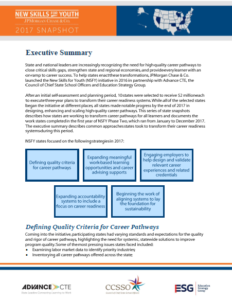 What defines a high-quality career pathway? Is it alignment to labor market needs and career opportunities? The quality and qualifications of teachers and faculty? Access to meaningful, aligned work-based learning experiences? Perhaps all of the above?
What defines a high-quality career pathway? Is it alignment to labor market needs and career opportunities? The quality and qualifications of teachers and faculty? Access to meaningful, aligned work-based learning experiences? Perhaps all of the above? 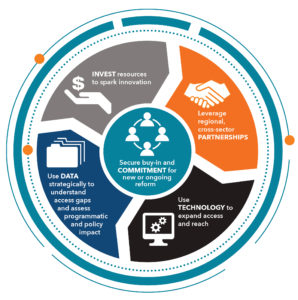
 In Nebraska, rural districts have been undertaking a wholesale needs assessment of local Career Technical Education (CTE) program offerings under the state’s reVISION initiative. Under reVISION, school and district leaders examine regional labor market data and hear from local employers to determine whether or not the programs available to students are those that are most in-demand.
In Nebraska, rural districts have been undertaking a wholesale needs assessment of local Career Technical Education (CTE) program offerings under the state’s reVISION initiative. Under reVISION, school and district leaders examine regional labor market data and hear from local employers to determine whether or not the programs available to students are those that are most in-demand. 
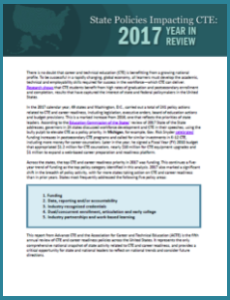 2017 was a banner year for Career Technical Education (CTE). Overall, 49 states and the District of Columbia passed a total of 241 policies related to CTE and career readiness, a marked increase from 2016. But while it is encouraging to see a groundswell of enthusiasm for CTE at the local, state and national levels, how will states leverage CTE’s momentum and ensure that state action translates to better outcomes for students?
2017 was a banner year for Career Technical Education (CTE). Overall, 49 states and the District of Columbia passed a total of 241 policies related to CTE and career readiness, a marked increase from 2016. But while it is encouraging to see a groundswell of enthusiasm for CTE at the local, state and national levels, how will states leverage CTE’s momentum and ensure that state action translates to better outcomes for students? 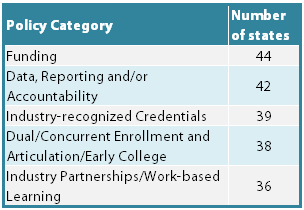 There was also a lot of activity related to data, reporting and accountability, largely due to state work around the Every Student Succeeds Act (ESSA). In 2017, 35 states identified measures of career readiness in their federal accountability systems, and many of these measures included industry-recognized credential attainment, dual-credit completion and work-based learning participation.
There was also a lot of activity related to data, reporting and accountability, largely due to state work around the Every Student Succeeds Act (ESSA). In 2017, 35 states identified measures of career readiness in their federal accountability systems, and many of these measures included industry-recognized credential attainment, dual-credit completion and work-based learning participation.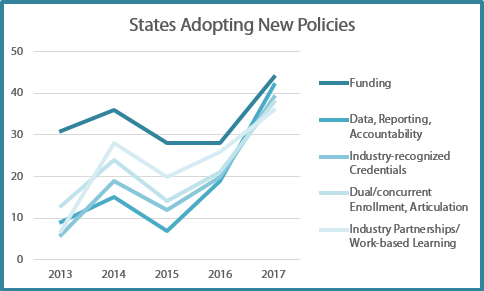
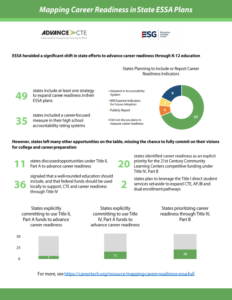 This year marked a pivotal moment for K-12 education. With the passage of the Every Student Succeeds Act (ESSA) in 2015, state leaders have spent the last two years reexamining and strategizing they way they deliver K-12 education. Now that the last ESSA plans have been written and submitted, we finally have a national picture of state priorities for education, including how K-12 education systems will support and reinforce career preparation opportunities.
This year marked a pivotal moment for K-12 education. With the passage of the Every Student Succeeds Act (ESSA) in 2015, state leaders have spent the last two years reexamining and strategizing they way they deliver K-12 education. Now that the last ESSA plans have been written and submitted, we finally have a national picture of state priorities for education, including how K-12 education systems will support and reinforce career preparation opportunities. 